
Recycled plastic sheets - cheap and good for the environment
For the sake of our environment - our recycled plastic sheets are made of high-quality, unmixed recycled materials and are an environmentally alternative to comparable virgin panels. Excellent quality - Made in Germany!
- We only offer you high-quality plastic sheets made of unmixed regenerated materials
- Recycled sheets are clearly cheaper and, thanks to recycling, contribute to less plastic waste
- Our recycling sheets are free from toxic plasticizers (such as phthalates)
ABS regenerated black grained cut to size
 from €7.91 / m2
from €7.91 / m2Incl. 19% Tax
ABS Regenerated Black grained 2x1 Meter
 from €9.47 / pcs
from €9.47 / pcsIncl. 19% Tax
PE-HD recyclate black grained custom cut
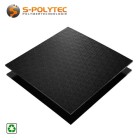 from €11.61 / m2
from €11.61 / m2Incl. 19% Tax
PE-HD recyclate black grained 2x1meter
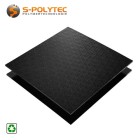 from €15.97 / pcs
from €15.97 / pcsIncl. 19% Tax
PE-HD Regenerate black grained on both sides cut to size
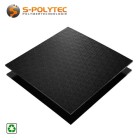 from €43.21 / m2
from €43.21 / m2Incl. 19% Tax
PE-HD Regenerate black grained on both sides 2x1 metre
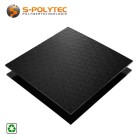 from €66.00 / pcs
from €66.00 / pcsIncl. 19% Tax
PE-UHMW (PE-1000) sheets black 2x1meter recyclate
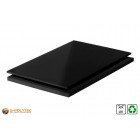 from €148.41 / pcs
from €148.41 / pcsIncl. 19% Tax
PE-UHMW (PE-1000) sheets green 2x1meter recyclate
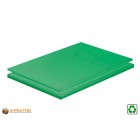 from €148.41 / pcs
from €148.41 / pcsIncl. 19% Tax
Recycled panels - Cheap and good for the environment
Recycled plastic panels in excellent quality - Made in Germany
Why should you use recycled panels
Recycling is a very important topic and especially nowadays, when the world's oceans are polluted by plastic waste, one should perhaps think about whether it really has to be a plastic sheet made of virgin material for the intended use, when there are excellent, environmentally friendly alternatives made of completely recycled plastic.
The advantages at a glance
- Every kilo of recycled plastic is made from one kilo of sorted plastic waste.
1 kilo less plastic waste that doesn't end up in incinerators or the world's oceans - Recycled panels are cheaper than comparable products made from virgin material
Recycled material is plentiful, so no new raw materials need to be extracted - Pure plastic scraps can be recycled almost as often as desired
Even off-cuts from recycled panels can be 100% recycled again - By recycling, the plastic as such does not change
Recycled sheets have comparable properties to plastic sheets made from virgin material
When are recycled plastic panels useful?
Apart from the lower price, recycled panels make sense above all from the point of view of environmental protection, because the panels consist of 100% recycled plastic waste, e.g. off-cuts, as they occur with our plastic panels when they are cut to size. This so-called plastic waste is therefore not disposed of and does not end up in landfills, is incinerated or shipped abroad for disposal. In addition, the raw materials required for the production of new plastic sheets, especially crude oil, can be dispensed with, because everything that a plastic sheet made of recycled material consists of is contained in the plastic itself.
Regardless of the reasons mentioned, it is often simply not even necessary to resort to plastic panels made from virgin material. It is not uncommon for plastics to be used as support structures or concealed housing parts, which can also be made of recycled material without any problems and without affecting the mechanical properties. Impact protection strips in garages and warehouses, panels for concrete construction, as root protection or enclosures for industrial plants, for example, can also easily be implemented with polyethylene regenerates.
When should recycled panels be dispensed with
Depending on the intended use, it may well be that the use of recycled panels is not possible because the desired plastic cannot be readily produced from recycled material. For most plastics, recycling can be implemented without any problems, but this does not yet apply to all materials.
Another reason when the use of recycled plastic sheets is out of the question is when the plastic sheets are to be used for optical purposes. When collecting plastic waste (commonly referred to in the vernacular and media as plastic waste), the utmost care must be taken in separating the individual plastics. Our production staff are trained in this area and are regularly made aware of the importance of separating the plastics we process by type. Unfortunately, this is not so strictly regulated in every plastics processing company, so that in rare cases small impurities can occur in the recycled material, which in the worst case can also affect the surface quality of the plastic sheet. In the case of co-extruded sheets, which consist of a carrier layer of reclaimed material and a top layer of virgin material, there is nothing to prevent them from being used visually, for example as decorative panels or exposed cladding.
Why are the recycled plastic panels almost always black?
Plastic sheets from virgin material come in all imaginable colours. However, recycling usually only separates plastics and not additionally colours, so that all colours are combined when the recycled material is shredded and ground. These are fused together in the extrusion process so that new plastic sheets can then be made from them. Depending on the mixing ratio of the individual colours, all variations of brown or grey tones would be created, without any guarantee of consistency in the colouring. To counteract this, a certain amount of carbon black is added to the regrind obtained from plastic waste in order to achieve a rich, strong black that can be reproduced at any time.
However, there are also regrinds in other colours up to white recycling plates. This is realised by using regrind that is pure in type and colour in combination with colour pigments in the desired colour. However, this is not the rule, so that co-extrudates also represent an alternative to the usually black recycling plates. Here, the plastic sheet consists of two layers that are inseparably joined during extrusion to form a homogeneous sheet. The carrier layer is usually made of black recycled material and takes up about 80% of the total thickness, while the top layer, with about 20% of the thickness, is made of virgin material that can be coloured as desired.
Delivery programme for environmentally friendly regenerates from S-Polytec
Our standard delivery programme for plastic sheets made from recycled material
- Black recycled ABS sheets made to measure in 1mm - 10mm thickness with grained surface on one side
- Black recycled PE-HD (PE-300) sheets made to measure in 1mm - 10mm thickness with one-sided grained surface
- Black recycling sheets made of PE-UHMW (PE-1000) as standard sheets in 10mm - 80mm thickness with a smooth surface on both sides
- Green recycling sheets made of PE-UHMW (PE-1000) as standard sheets in 10mm - 80mm thickness with smooth surface on both sides
On request, we also supply recycled panels in the following formats
- ABS recycling sheets in black extruded to size, optionally with grain on one side - already from 500kg
- Polystyrene recycled panels in black extruded to size, optionally with grain on one side - from as little as 500kg
- Acrylic glass made from recycled material (Green Cast) as standard sheets in 3050mm x 2030mm - from as little as 1 sheet
- Co-extruded ABS with one-sided surface in desired colour made to measure from virgin material - from 3,000kg
- Co-extruded polystyrene with a surface on one side in the colour of your choice, made to measure from virgin material - from 3,000kg
- and much more
Areas of application for recycled plastic sheets
The areas of application for plastic sheets made from recycled material are basically no different from the applications offered by plastic sheets made from virgin material. Although the smallest impurities can be contained in the recycled sheets of technical plastics, this can be almost completely disregarded for the majority of applications. In the case of recycled acrylic glass, the optical effect is even identical to sheets made from virgin material due to the complex filtration of the recycled material, so that there are no differences here to acrylic glass sheets made from virgin material.
NOTE: Regenerates do not change the properties. ABS remains ABS and so ABS regrind has the same positive properties as ABS.
Typical examples for the use of recycled panels
- Root protection panels in gardening and landscaping made from recycled polyethylene
- Wall and impact protection in warehouses, on construction vehicles or trucks made of recycled polyethylene
- Environmentally friendly workpiece carriers and trays made of polystyrene or ABS regenerates
- High-quality product presenters, e.g. for cosmetics, made of recycled acrylic glass
- Plastic housings and covers made of impact-resistant ABS recycled plastic
- Office utensils made of plastic based on PS recyclate or ABS recyclate